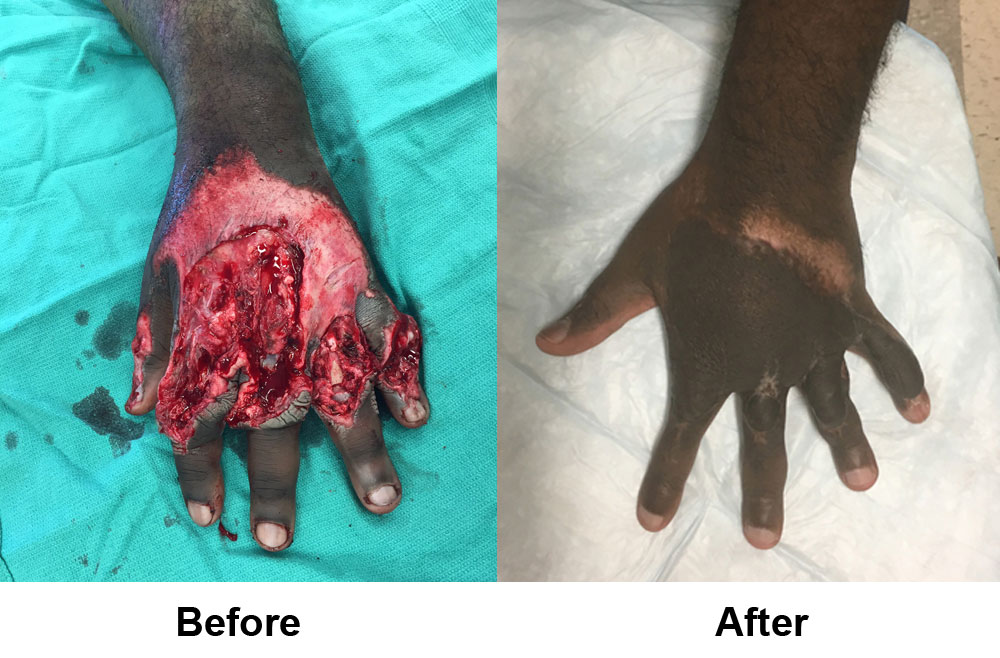 The hand specialists at Penn Orthopaedics and Penn Plastic Surgery have integrated their services to provide comprehensive care for patients with hand and wrist injuries.
The hand specialists at Penn Orthopaedics and Penn Plastic Surgery have integrated their services to provide comprehensive care for patients with hand and wrist injuries.
Like many academic medical centers, Penn Medicine once offered two options to patients requiring hand surgery: plastic surgeons for soft tissue coverage and microsurgery, and orthopaedic hand surgeons for fracture work, carpal instability and wrist arthroscopy. What this meant, however, was that patients with both soft tissue and orthopaedic needs were treated independently, in different locations, with their appointments possibly separated by hours or days.
In the days following Penn Medicine’s second monumental bilateral hand transplant (an event that united plastic and orthopaedic surgeons, microsurgical specialists, neurovascular surgeons, and a host of others), it became evident that this collaborative approach was the optimal way to care for all hand and wrist patients.
The future of surgery for hand patients at every level of injury or dysfunction at Penn would be defined by the integration of orthopaedic and plastic surgeons. The full integration of the two services took place in the Fall of 2018.
Reflecting on the combined program, L. Scott Levin, MD, Chair of the Department of Orthopaedic Surgery and Professor of Plastic Surgery at Penn Medicine and recently elected President of the American Society for the Surgery of the Hand (ASSH), noted its shared objectives.
 “As an institution, Penn Medicine has always been defined by collaboration, and this holds true of the hand surgery programs. Whether we’re operating on the bones and tendons or the muscles, nerves, vasculature, and soft tissue, we share the same commitment and goals—so it made sense for us to join forces.” — L. Scott Levin, MD.
“As an institution, Penn Medicine has always been defined by collaboration, and this holds true of the hand surgery programs. Whether we’re operating on the bones and tendons or the muscles, nerves, vasculature, and soft tissue, we share the same commitment and goals—so it made sense for us to join forces.” — L. Scott Levin, MD.
(Article continues below.)
Integrated Care and Patient Pathway Optimization
David J. Bozentka, MD, Chief of Hand Surgery at Penn Orthopaedics describes the integration as the best of two worlds. “It’s allowed us to combine our strengths and our expertise for the greatest spectrum of patients.”
The integrated program brings every condition under a single umbrella, from trigger finger or De Quervain's tenosynovitis to severe trauma, vascular disorders, Lupus-associated deformity and nerve compression injuries. This is only possible because the program integrates every aspect of hand surgery, including arthroplasty, brachial plexus reconstruction, tendon grafts, microvascular surgery, nerve repair, and hand transplantation to provide the best possible treatment plan for patients.
This integrated approach allows Penn to look at the unique patient pathways for hand and wrist patients – like patients with distal radius fractures. Among the most common wrist injuries the hand services see are distal radius fractures.
“Facilitated by the integrated program, we’ve developed a pathway for the treatment of wrist fractures—one of the most common upper extremity injuries-- that goes beyond simply setting bones,” Dr. Bozentka says. The pathway incorporates best practices that prevent factors that can impede healing or weaken bone structure, including osteoporosis assessment and nerve-related issues associated with fracture.
 29 year old male with multiple complex open fractures resulting from a car accident. The Penn team performed multiple complex surgeries which allowed the patient to maintain good hand function and aesthetics.
29 year old male with multiple complex open fractures resulting from a car accident. The Penn team performed multiple complex surgeries which allowed the patient to maintain good hand function and aesthetics.Although the hand surgeons have always collaborated on complex cases, they now have the opportunity to interact on every case. In the care of a typical patient, for example, the combined service provides access to multiple physicians. “It’s an easier, more seamless process for patients to maneuver, particularly if they need multiple visits requiring care from both services,” observes Dr. Bozentka.
Research and Academics
Although patients are the principal beneficiaries of the combined hand programs, the advantages of the integration extend to academics and research, as well.
“As a group, the plastic and orthopaedic surgeons meet once a month to discuss research and review papers,” says Dr. Bozentka. “Aside from sharing these projects, and the opportunity to interact with the residents from both specialties, these events allow us to better understand each other’s thought processes and the perspective we bring from our respective experiences and training.”
Garnering a better understanding of distinctions in plastic surgery and orthopaedics hand surgery training prior to the program integration was the objective of a 2016 study conducted by Penn Integrated Hand Surgeons Drs. Levin, Lin, Chang and Silvestre. The first objective comparison of didactic hand training in the United States, the study sought to assist future efforts to unify training by identifying areas of relative weakness that highlight the need for “cross-pollination” between specialties.
Importantly, the study found greater emphasis in plastic surgery training for wound management and muscle/tendon injuries and less emphasis on fractures and dislocations– a deficiency that could lead to under-preparation among plastic surgery residents relative to their orthopaedic colleagues. The authors then called for a nation-wide optimization of hand surgery training specifically within plastic surgery.
“This really was a wake-up call for both the orthopaedic and plastic surgery hand communities in the United States,” says Dr. Levin. “These results and the benefits that we see for our patients in the clinic are at the heart of the efforts we’ve made in developing the integrated hand program at Penn Medicine.”